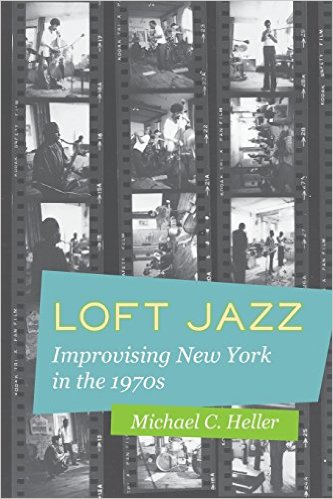 Technically, the term “loft jazz” doesn’t refer to a particular style. It is generally associated with free jazz performed within converted lofts in lower Manhattan during the 1970s. At that time, the lofts provided performance opportunities for musicians whose styles were too avant-garde for mainstream nightclubs. Throughout the history of the lofts, much of the music was recorded, but little of it was issued commercially. Thus, it remains one of the most misunderstood periods of jazz history. Michael C. Heller’s new history, “Loft Jazz: Improvising New York in the 1970s” (University of California Press), discusses every aspect of the scene in great detail—except for the music.
Technically, the term “loft jazz” doesn’t refer to a particular style. It is generally associated with free jazz performed within converted lofts in lower Manhattan during the 1970s. At that time, the lofts provided performance opportunities for musicians whose styles were too avant-garde for mainstream nightclubs. Throughout the history of the lofts, much of the music was recorded, but little of it was issued commercially. Thus, it remains one of the most misunderstood periods of jazz history. Michael C. Heller’s new history, “Loft Jazz: Improvising New York in the 1970s” (University of California Press), discusses every aspect of the scene in great detail—except for the music.
In the preface, Heller aligns his work with “the new jazz studies” which reconsiders the canonical version of jazz history. Heller opts for a community based approach which he says allows scholars to examine a broad swath of musical meanings that spill over into other spheres. Heller does a very good job of bringing this period and its community to life. He focuses a lot of his text on saxophonist Juma Sultan and his loft space, Studio We. Heller also writes about RivBea, run by Sam Rivers and his wife Beatrice (generally considered the best-managed loft), and its closest competitors, Ladies Fort and the Jazz Forum. During the 1970s, the music expanded from the lofts into the streets, with the annual New York Musician’s Jazz Festival—intended as a counter-festival for the more commercial (read: straight-ahead) Newport in New York fest—as well as concerts performed in city parks and community centers. The lofts, which served as housing, rehearsal space and performance venues, were usually converted factories, and Heller offers remarkable anecdotes about how the musicians found ways to upgrade the spaces, and live cheaply off-the-grid.
While all of this information is valuable for an understanding of the period, the lack of musical analysis prevents the reader from seeing the entire picture. Perhaps the best-known collection of loft jazz recordings was a series of 5 LPs titled “Wildflowers”. Recorded in May 1976 at RivBea, the albums contain performances by some of the best players on the loft scene, including David Murray, Sam Rivers, Olu Dara, Oliver Lake, Sunny Murray, Fred Hopkins, Wadada Leo Smith, Makanda Ken McIntyre, as well as established free jazz groups like Air and the Revolutionary Ensemble. At present, the 3-CD reissue is out of print, but the set can be streamed in its entirety on Spotify. Heller mentions the set a couple of times, but never delves into the riches found within its tracks. Instead, his sole attempt at musical analysis deals with a pair of recordings by Sonny Simmons which most jazz fans have never heard. Heller compares the version of “Zarak’s Symphony” on “Music from the Spheres” (ESP-Disk) to an unissued rehearsal tape found in Juma Sultan’s personal archive. I appreciate that Heller describes musical elements that appear on the tape but not on the LP, but without access to the tape, the analysis is of limited value. It would have been better to discuss tracks from “Wildflowers” so that interested readers could listen to the recording while reading the musical analysis.
Heller is a university professor, and unfortunately that means that the reader is subjected to the verbal wasteland known as “academic writing”. While Heller relates the historical narrative in a straight-forward style, his theoretical conclusions are delivered in dense, turgid prose featuring tortured verb constructions like “problematize”, seemingly endless sentences (On one behemoth, I counted 115 words between periods!) and long-winded previews of the chapters to come (“In Chapter 1, I will discuss… and in Chapter 2, I will examine…”). When I was in college, I was taught to write with clarity, using easily-accessible terms and limited jargon. I considered George Orwell’s essay “Politics and the English Language” as my second Bible. Mr. Heller should revisit Orwell’s work immediately (although it might “problematize” his writing style!)
Thankfully, Heller’s monograph is not the last word on the loft scene. Brent Hayes Edwards is working on a book which promises to be more inclusive than Heller’s tome. Edwards plans to discuss recordings, offer an in-depth look at Ornette Coleman’s loft space Artists House, and further examine the ways that loft music was programmed by musicians and producers. The latter discussion may be quite valuable: although Heller fails to make the connection, the current trend of house concerts mirrors the concept of the lofts. While the homeowners are generally in charge of hiring the musicians and suggesting music, there are some outside producers who book and program house concerts. The musical fare today has flipped from the 1970s—most house concerts focus on straight-ahead jazz while former loft musicians like David Murray now fill mainstream jazz clubs like Birdland. However, the lessons learned by the owners and musicians of the 1970s lofts could resonate with those who present concerts in their own homes. For those people, Heller’s sociological approach may offer a few pertinent answers to lingering issues.